1. Formal Dining Tables That Seat 10+
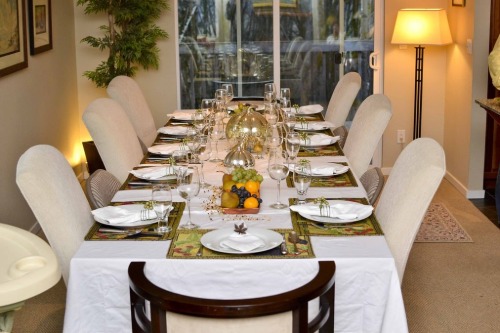
Massive dining tables that seat 10 or more were once a staple for hosting grand dinners, but in 2025, they’re often collecting dust. With remote work and smaller households on the rise, most people aren’t entertaining that many guests at once. These oversized tables eat up square footage and can make even spacious dining rooms feel cramped. Many homeowners are opting for extendable tables that offer flexibility without dominating the space.
On top of that, the modern shift toward open-concept living favors multifunctional areas over rooms with single purposes. A table that can double as a workspace or craft station is far more useful day-to-day. Formal dinners happen less frequently now, often replaced by casual gatherings or even shared meals outdoors. Keeping a table just for the occasional holiday spread no longer justifies the real estate.
2. China Cabinets

China cabinets were once prized display pieces, showing off heirloom dishware and fancy glassware. But in 2025, they’re increasingly seen as clunky and unnecessary. Open shelving or minimalistic built-ins are now preferred, as they make a room feel lighter and more modern. Plus, most people simply don’t collect fine china anymore, and if they do, it’s stored more efficiently elsewhere.
The bulky footprint of a china cabinet can dominate a room that could otherwise be more versatile. Millennials and Gen Z buyers especially favor furniture that earns its keep by being practical and space-saving. A storage piece that holds one-use items doesn’t really fit that mindset. People are far more likely to invest in functional storage for multi-purpose use or entertaining essentials they actually use regularly.
3. Matching Dining Sets
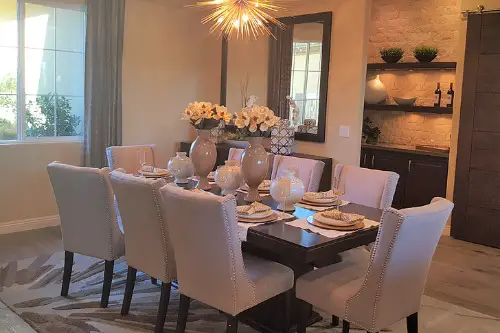
Gone are the days when a dining table and chairs had to be perfectly coordinated. In 2025, homeowners are leaning into eclectic styles that feel curated, not catalogued. Mixing materials, finishes, and even eras gives a dining space more personality and visual interest. Matching sets can feel too rigid and overly traditional in a time when personal expression is king.
What’s more, mismatched furnishings are often more cost-effective and sustainable. You can upcycle vintage pieces or buy high-quality chairs over time rather than splurging on a complete set all at once. With more awareness of fast furniture waste, people want timeless, collected looks—not cookie-cutter suites. Design has moved on from uniformity to individuality.
4. Wall-to-Wall Carpeting
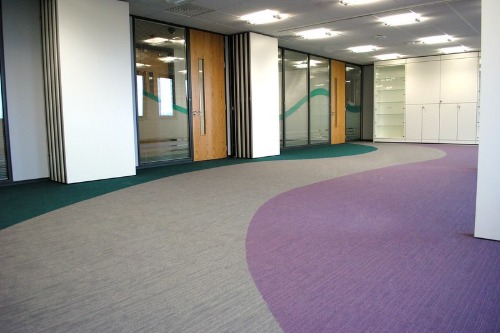
Wall-to-wall carpet in a dining room may have once felt luxurious, but now it’s just a magnet for stains and allergens. In 2025, hard surfaces like engineered wood, luxury vinyl plank, or even sealed concrete are far more practical and stylish. Carpet under the dining table just doesn’t make sense when you’re dealing with food and drink. Cleaning a rug is one thing—cleaning carpet is a whole different story.
People are eating at home more than ever, but they also expect their spaces to be easy to maintain. With kids, pets, and frequent use, spill-friendly flooring is a must. Area rugs can still add warmth and texture without being a permanent trap for crumbs. And let’s be honest—who really wants to deal with red wine on beige carpet?
5. Overly Ornate Chandeliers

Elaborate, crystal-laden chandeliers used to be the crown jewel of dining rooms. But in 2025, they’re being replaced by lighting that’s simpler, sleeker, and more energy-efficient. LED pendants, minimalist fixtures, or even smart lighting with dimmable features are far more in tune with today’s tech-savvy homes. Ornate lighting can look outdated and overly formal in spaces that are meant to be relaxed and flexible.
Homeowners now want lighting that enhances function and mood, not just looks impressive. With the popularity of dim-to-warm LEDs, lighting can shift from dinner-party ambiance to work-from-home brightness at the touch of a button. Huge chandeliers also tend to clash with the streamlined furniture and clean lines that dominate current design. The goal now is harmony, not grandiosity.
6. Dining Rooms Cut Off From the Kitchen

Once considered a mark of refinement, a dining room completely closed off from the kitchen now feels like a logistical hassle. In 2025, open floor plans or at least semi-open concepts are preferred for better flow and easier entertaining. No one wants to carry hot dishes down a hallway just to serve a meal anymore. The trend now is about keeping the cook part of the conversation, not tucked away in another room.
Even in new builds, formal dining rooms are being reimagined as flex spaces or combined with kitchens in a more communal layout. It’s about function and connection—people want to eat, chat, and cook in the same shared area. This shift also supports multitasking, like helping kids with homework while prepping dinner. The days of isolated dining are dwindling fast.
7. Chair Rails and Wainscoting Overload
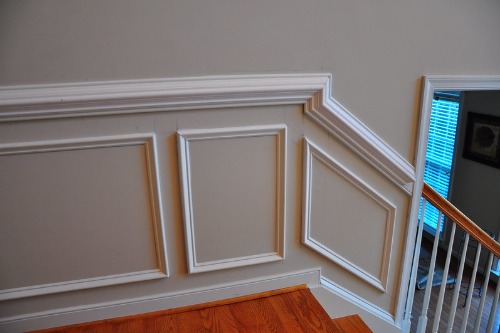
Chair rails and wainscoting were once go-to features for adding elegance to a dining room, but now they often feel fussy or overly decorative. In 2025, cleaner walls with bold paint or wallpaper accents are more in style. Too many trim details can make a room feel boxed-in or too traditional for modern tastes. Plus, chair rails are rarely installed at the correct height, which can throw off the visual balance of the space.
Homeowners are instead using wall treatments in more creative ways—like oversized art, textured wallpaper, or statement murals. These updates add interest without the commitment of permanent millwork. Also, with the DIY boom still going strong, people are choosing simpler upgrades they can tackle themselves. Wainscoting requires precision, while a painted accent wall just needs a roller.
8. Corner Hutches

Corner hutches used to be a clever way to use awkward dining room angles, but in 2025 they often just feel…awkward. These furniture pieces can look dated and tend to limit how you can arrange the rest of the room. Today’s dining areas favor open sightlines and streamlined furniture, especially in smaller homes or apartments. A clunky hutch disrupts that flow and can make a space feel more cramped than cozy.
Modern storage solutions are more integrated and often built into the wall or tucked into adjacent spaces. People prefer cabinetry that blends in rather than stands out, particularly when the trend is moving toward minimalist design. If you need storage, a sideboard or buffet with clean lines fits the bill without overwhelming the space. And let’s face it, how often are we really reaching for that gravy boat?
9. Ceiling Medallions
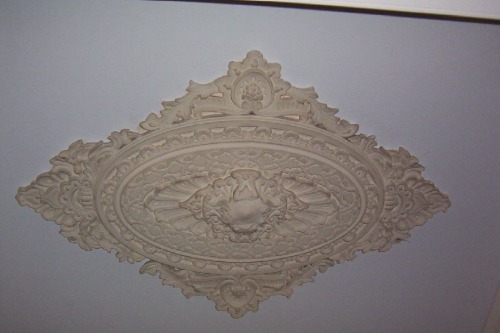
Ceiling medallions may have added historic charm to older homes, but in 2025 they often feel unnecessary unless you’re truly restoring a period property. They tend to compete with modern lighting fixtures rather than complement them. As interior design leans toward minimalism and integrated smart tech, decorative ceiling flourishes just don’t make much sense. It’s one more thing to dust, and it usually doesn’t add function.
Homeowners are focusing more on practical ceiling features like flush lighting, exposed beams, or even skylights to bring in natural light. In a dining area, attention is better spent on statement lighting that fits the room’s aesthetic and purpose. Ceiling medallions can make a sleek fixture look mismatched or out of place. Design today is about intention, not ornament for ornament’s sake.
10. Built-In Wet Bars
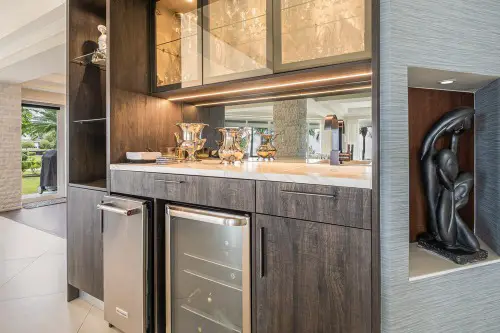
Once considered the ultimate in home entertaining, built-in wet bars in dining rooms are quickly falling out of favor. In 2025, space is too precious to dedicate to a feature that’s only used occasionally. Portable bar carts or pantry-style beverage stations offer the same convenience without taking up permanent real estate. Plus, many people now prefer serving drinks in more casual spaces like outdoor patios or living rooms.
There’s also a cultural shift away from alcohol-centric entertaining in some households. With rising interest in sober living and wellness, fewer people feel the need to spotlight alcohol as a design feature. If anything, coffee stations or sparkling water taps are becoming the new gathering points. A built-in bar just doesn’t serve the modern lifestyle the way it used to.
11. Oversized Buffets and Sideboards

Oversized buffets and sideboards were once considered must-haves for storing linens, dishes, and serving ware. But in 2025, they’re often too bulky for today’s more streamlined, multifunctional dining spaces. With storage now often integrated into kitchen islands or hidden cabinetry, there’s less need for giant furniture pieces crowding the room. They also tend to get cluttered with random décor that collects dust rather than adds value.
Today’s dining areas call for pieces that serve multiple roles without dominating the space. A sleek console table or floating shelf can hold essentials without overwhelming the room. With many people downsizing or embracing minimalist design, there’s simply no room for excess. It’s about making space work smarter—not stuffing it with more stuff.
This post 11 Dining Room Features That No Longer Make Sense in 2025 Homes was first published on Greenhouse Black.
